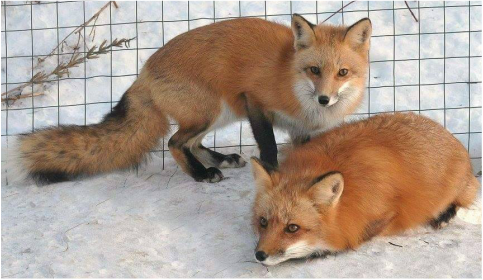Vulpes genus

Fennec fox (Vulpes zerda)
Fennec foxes are the smallest foxes and canids in the world. They live in the Northern countries of Africa, in very desertic areas. Their large ears help them regulate their body temperature to not overheat. They prey on small rodents, reptiles and insects, birds and sometimes, eat certain plants. They mostly stay hydrated with the blood from their prey, as the water sources aren't always common in the deserts they inhabit. Fennec foxes are, with red foxes, the species of fox most commonly seen in the pet trade. They are considered, along with gray foxes, to be the easiest foxes in a domestic setting; however they remain foxes, with habits and instincts which cannot be trained out of them. Picture source: Foxes & Friends, of Eevee. |

Ruppell's fox (Vulpes rueppellii)
Ruppell's foxes, resembling fennec foxes, live in North Africa, certain parts of Asia and in the Middle East. These foxes, which are unheard of in the exotic pet trade, are omnivores which adapt their diet according to what is found in the region of the globe they inhabit. They can prey on small mammals, birds, reptiles, rodents and sometimes, eat plants and berries. Picture source: Wikipedia. |
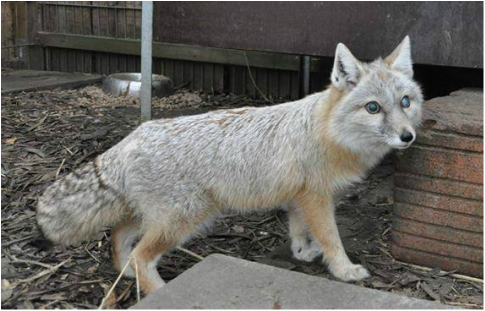
Corsac fox (Vulpes corsac)
Corsac foxes, which resemble swift foxes in appearance, are a medium sized species of fox found in central Asia and in some parts of Russia, too. These foxes primarily prey on rodents and insects, while also scavenging on occasion, catching birds or medium sized mammals, or even eating plants and fruits. They are adapted, like fennec foxes, to survive without drinking for long periods of time. They get their source of liquids from the blood of their prey. They are the only species of fox to have round pupils. Corsac foxes are not common in the pet trade, although there are individuals owning and breeding them in Europe. Picture source: Wildtierhilfe Fiel. |

Bengal fox (Vulpes bengalensis)
Also known as Indian foxes, Bengal foxes are a small-to-medium sized fox endemic to India and areas surrounding India. Unlike red foxes, the tip of their tail is exclusively black. These foxes are hunted for their pelt and for their skin by the locals they share their territory with. Their native lands are not protected, and are annually converted into agricultural lands or villages, which is the greatest threat for this species. Bengal foxes eat rodents, birds, fish and crabs, reptiles and occasionally fruits. They are not common at all in the exotic pet trade. Picture source: Stock image, free to use. |
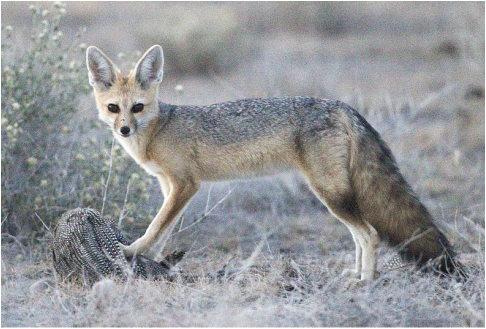
Cape fox (Vulpes chama)
The cape fox is a small-to-medium sized species of fox endemic to the southern areas of Africa. It is referred to as the silver-backed fox or the cama fox. When cape foxes are happy or excited, they lift their tail, rather than wagging it. The higher the tail, the more excited the fox is. These foxes are also capable of mating all year long, like domestic dogs, which is unusual for a wild canid (females and males are only fertile once a year, generally, in all wild canid species). Cape foxes eat small mammals, birds and fruits, but they can prey on reptiles and invertebrates too. Cape foxes have been unheard of in the exotic pet trade. Picture source: Wikipedia. |

Pale fox (Vulpes pallida)
The pale fox is a small species of fox found all the way from east to west in northern Africa. Pale foxes are very elusive; there is not much information available about them in the wild. They are known to generally prey on small rodents, birds, reptiles and insects, which they catch at dusk, after coming out of their burrows which they dig in sand. They are rarely seen during the day, as they stay inside their dens to protect themselves from the heat of the sun. There are 5 subspecies of pale foxes. Pale foxes are found in the exotic pet trade, but they remain rare and are not generally seen as pets. Picture source: Michael Lorentz. |
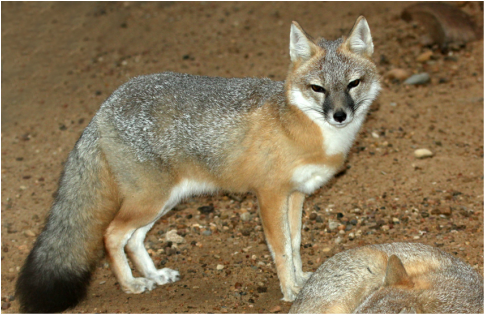
Swift fox (Vulpes velox)
Swift foxes are small-to-medium sized foxes, similar in appearance to kit foxes (with which they are known to breed where their territories overlap) and corsac foxes. They live in northern areas of the United States as well as in the middle of the US (Texas, Montana, New Mexico, Colorado and Oklahoma), and can also be found, in smaller numbers, in some southern areas of Canada (Saskatchewan, Manitoba and Alberta), where they are a protected species. Swift foxes live in prairies and deserts, where they feed on rodents, insects, birds, reptiles and fruits. They occasionally scavenge, too. Swift foxes are found in the exotic pet trade, but they remain rarely seen as domestic companions. Picture source: Wodahseht. |
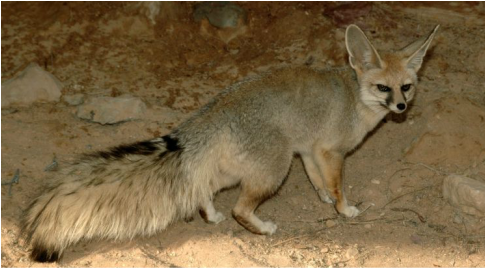
Blandford's fox (Vulpes cana)
Blandford's foxes, which are known to be the second smallest canids, the first being the fennec fox, are endemic to the Middle East and Central Asia. These small foxes, which have a similar appearance to fennec foxes, are unheard of in the exotic pet trade. Blandford's foxes, also known as Afghan foxes, eat fruits as a big part of their diet. They also prey on insects and smaller rodents. Picture source: Arkive. |
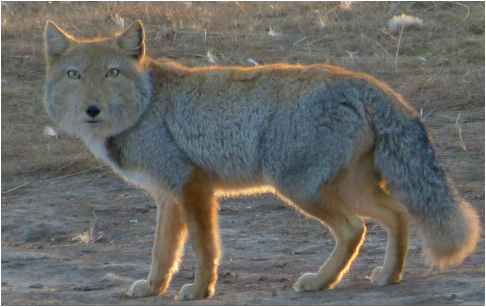
Tibetan fox (Vulpes ferrilata)
The Tibetan sand fox is a medium-to-large sized fox, endemic to the Tibetan plateau in southern Asia, near India (Nepal, China, Bhutan and Sikkim). Their head appears proportionally too large in relation to their body, which gives them an unusual look, unlike that of any other fox species. Their main source of food are the Plateau pikkas, but they also prey on other small or larger rodents and reptiles. They are occasionally seen scavenging on deer, livestock and antelopes. Tibetan foxes take very good care of their young, staying with them until they are almost a year old. Tibetan foxes are unheard of in the exotic pet trade. Picture source: Richard Webb. |
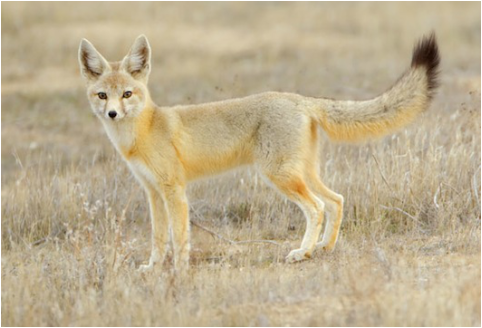
Kit fox (Vulpes macrotis)
The kit fox is a fox endemic to Southwestern areas of the United States, such as Oregon, California, Texas, Mexico, Utah, Nevada and Arizona. These small-to-medium sized foxes resemble swift foxes, with which they are known to breed in areas where their territories overlap. There are 3 known subspecies of kit foxes, one being the rare San Joaquin kit fox. Kit foxes are omnivores, preying on small or larger rodents, reptiles, ground birds and fish. They are known to scavenge and eat fruits, on occasion. Picture source: Mark Chappell. |
Urocyon genus
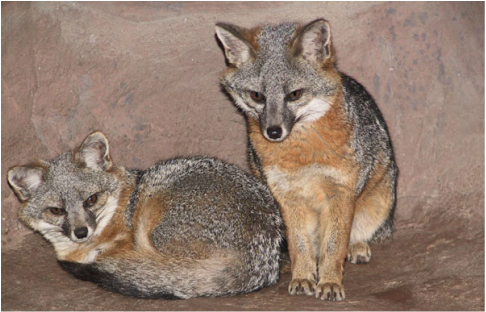
Island fox (Urocyon littoralis) Island foxes, also known as coast foxes, are similar in appearance to gray foxes except for their size, which is visibly smaller. There are 6 known subspecies of island foxes, all of which are unheard of in the exotic pet trade. Island foxes are the smallest fox species in North America, having the size of a common domestic cat. Island foxes prey on small rodents, birds, reptiles, invertebrates and occasionally eats fruits. Picture source: Brendan Byrne. Cozumel fox (extinct/critically endangered species)
Cozumel foxes are a fox species of the genus Urocyon, slightly smaller than a common gray fox but larger than an island fox. They had the coloration of a gray fox (silver tipped gray fur, black stripe on the tail, orange chest and belly with white areas). Fossils indicate they got isolated on the island of Cozumel, Mexico, about 5000 yrs. ago. It is unsure whether they still exist or not, as the last reported sighting of a Cozumel fox goes back to 2001. |

Gray fox (Urocyon cinereoargenteus)
Gray foxes are a species of fox of medium size, endemic to the southern areas of North America (southern Canada and most of the United States), Central America (Mexico) and the northern regions of South America (Venezuela and Colombia). It is the only canid whose habitat ranges from North America to South America, and the only known fox species in America that is able to climb trees. The genus Urocyon, which includes gray foxes, island foxes and the rare/possibly extinct Cozumel fox, is the most primitive genus of fox. Gray foxes are quite common in the exotic pet trade in North America. It's been said that gray foxes, along with fennec foxes, are the easiest fox species to handle in captivity as pets, out of all the species known to currently be found in the exotic animal pet trade (however, keep in mind they are still foxes with fox instincts and are not like cats or dogs). Gray foxes prey on rodents of small or larger size, birds, reptiles, eggs and fruits, which are an important part of their natural diet. Picture source: Ronnie Strack, Wild Canid Conservation Center. |
Otocyon genus
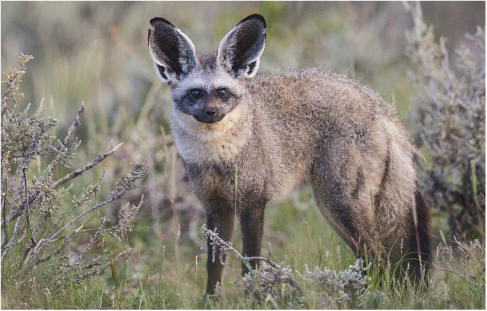
Bat-eared fox (Otocyon megalotis)
Bat-eared foxes are the unique fox species of the genus Otocyon. They are a small fox species found in some areas of southern Africa and southeastern Africa. There are two recognized subspecies of bat-eared foxes. Unlike most foxes, bat-eared foxes are mostly insectivores, preying on termites. They are also known to eat ants, millipedes, beetles, scorpions, grasshoppers, spiders and other invertebrates. They rarely prey on small rodents, birds or reptiles. Bat-eared foxes are also very social animals that often live in pairs or in small groups that can do up to a dozen individuals. Although it is not a common sight, they can be found in the exotic pet trade in North America and Africa.
Picture source: Wikipedia.
Bat-eared foxes are the unique fox species of the genus Otocyon. They are a small fox species found in some areas of southern Africa and southeastern Africa. There are two recognized subspecies of bat-eared foxes. Unlike most foxes, bat-eared foxes are mostly insectivores, preying on termites. They are also known to eat ants, millipedes, beetles, scorpions, grasshoppers, spiders and other invertebrates. They rarely prey on small rodents, birds or reptiles. Bat-eared foxes are also very social animals that often live in pairs or in small groups that can do up to a dozen individuals. Although it is not a common sight, they can be found in the exotic pet trade in North America and Africa.
Picture source: Wikipedia.
'False foxes'
False foxes are a unique genus of canids from South America, more closely related to jackals, wolves and coyotes than foxes, but whose appearance closely resemble that of true foxes: bushy tail, narrow and pointy muzzle, general morphology... some of them even have vertical cat-like pupils! There are 7 species of false foxes, divided in two genera: Cerdocyon (1 existing species) and (6 existing species).
False foxes are a unique genus of canids from South America, more closely related to jackals, wolves and coyotes than foxes, but whose appearance closely resemble that of true foxes: bushy tail, narrow and pointy muzzle, general morphology... some of them even have vertical cat-like pupils! There are 7 species of false foxes, divided in two genera: Cerdocyon (1 existing species) and (6 existing species).
Cerdocyon genus

Crab-eating fox (Cerdocyon thous)
Crab-eating foxes, also known as wood foxes, are the only species of canid of the genus Cerdocyon. They are native to the northern and eastern regions of South America. Crab-eating foxes can adapt themselves to different types of environment, as they are found in jungles, rainforests, savannas, swamps, woodlands and even plains. Their colour varies from dark to light grey, dark to light brown or yellowish. They are social animals who mate for life and are often seen with other bonded pairs. These canids primarily prey on crabs, but they are known to also prey on rodents, birds, insects and other types of crustaceans. These canids are commonly kept as pets by locals in South America, and they are said to be very easy to tame, obedient and friendly animals.
Picture source: Cristian Correa, used with his permission.
Crab-eating foxes, also known as wood foxes, are the only species of canid of the genus Cerdocyon. They are native to the northern and eastern regions of South America. Crab-eating foxes can adapt themselves to different types of environment, as they are found in jungles, rainforests, savannas, swamps, woodlands and even plains. Their colour varies from dark to light grey, dark to light brown or yellowish. They are social animals who mate for life and are often seen with other bonded pairs. These canids primarily prey on crabs, but they are known to also prey on rodents, birds, insects and other types of crustaceans. These canids are commonly kept as pets by locals in South America, and they are said to be very easy to tame, obedient and friendly animals.
Picture source: Cristian Correa, used with his permission.
Lycalopex genus
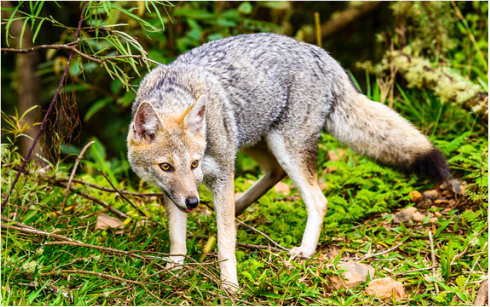
Pampas fox (Lycalopex gymnocercus)
Pampas foxes, also known as Azara's zorros, are medium-sized canids endemic to central South America and northeastern South America, specifically Brazil, Uruguay, Argentina, Paraguay and Bolivia. They are hunted for their fur or because they are accused by farmers of killing their livestock. Pampas foxes are opportunistic feeders, preying on rodents, insects, reptiles and birds. They often eat eggs, fruits, plants and will not hesitate to scavenge if they find the carcass of an animal. Pampas foxes are not found in the pet trade, but they are occasionally kept as pets by the locals of South America. Picture source: Wikipedia. |
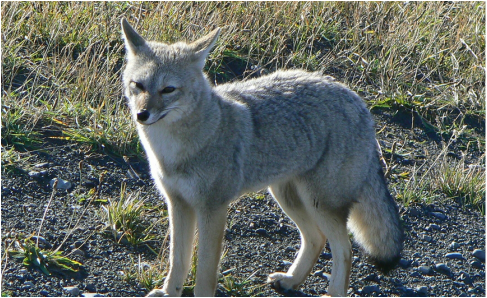
South American gray fox (Lycalopex griseus) South American gray foxes are a species of canid endemic to the southwestern regions of South America. These medium sized canines, also known as chilla foxes, generally prey on small or large rodents, birds, reptiles and arthropods, but they can be seen eating eggs, fruits, plants or on occasion, scavenging. These mammals are often hunted for their pelt and because they are accused of attacking livestock. They are commonly kept as pets by the locals in South America. Picture source: Wikipedia. |

Culpeo fox (Lycalopex culpaeus)
Culpeo foxes, also known as Andean foxes or Chilean foxes, are the largest species of canid, after maned wolves, endemic to South America. They are found all across the western side of South America, from Ecuador to Tierra del Fuego. They are also found on the Falkland Islands, where they were introduced by humans. They are opportunistic predators, eating rodents, birds, insects, young livestock and carrion. Culpeo foxes were domesticated by the native Yaghan of Tierra del Fuego, taking the name of Fuegian dogs. Fuegian dogs (the domesticated form of the culpeo fox) were white, beige with white or black markings or tawny, larger than an average culpeo fox but with a nearly identical morphology. More info on Fuegian dogs here and here. Nowadays, culpeo foxes are commonly kept as pets by the locals in South America, but they are not found in the exotic pet trade. Picture source. |
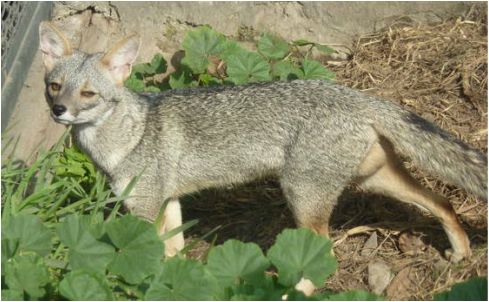
Sechuran fox (Lycalopex sechurae)
The Sechuran fox, also known as the Peruvian fox, is a small canid, approximatively the size of a common gray fox (Urocyon cinereoargenteus) but resembling the South American gray fox in coloration. Sechuran foxes are endemic to Ecuador and Peru, inhabiting the Sechura desert (which gives them their name). These small predators are opportunistic feeders, generally preying on rodents, birds, insects and eating, on occasion, fruits, plants and eggs. Their body allows them to survive on a strictly vegetarian diet, if necessary, which is a unique adaptation. They are unheard of in the exotic pet trade but they are, occasionally, kept as pets by the locals in Peru and Ecuador. Picture source. |
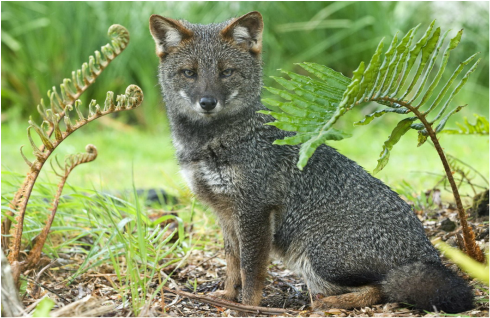
Darwin's fox (Lycalopex fulvipes) Darwin's fox, also known as the Chilote fox, is a small-to-medium sized species of canid similar in coloration to the common gray fox. Darwin's foxes are critically endangered, with only about 300 individuals still existing on the Chilean mainland (around 70 individuals) and on the Chiloé island (around 250 individuals). Darwin's foxes prey on rodents, small mammals, birds, reptiles and invertebrates. They occasionally eat fruits and rarely scavenge. Darwin's foxes are not found in the exotic pet trade, although there was a report of a local selling a tamed young male Darwin's fox for 500,000 chilean pesos, as a pet, to make profits. It is unknown whether the fox was released, confiscated or sold. Picture source. |
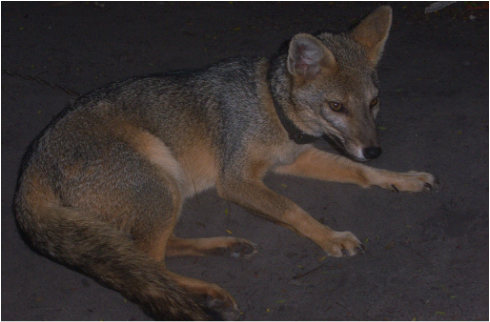
Hoary fox (Lycalopex vetulus) The hoary fox is a small-to-medium sized species of canid endemic to the central regions of Brazil. Hoary foxes mostly eat insects, such as beetles and termits, but are not insectivores as they also feed on rodents, birds and eggs, occasionally eating fruits and plants, too. Hoary foxes are not found in the exotic pet trade, however, they are very commonly kept as pets by the locals in South America, which claim that they are very easy to tame, extremely loyal and very friendly animals. Picture source: Wikiwand. |
None of the pictures used mine, unless claimed otherwise. Those pictures were used with permission or were used from free stock images, which were not copyrighted.
